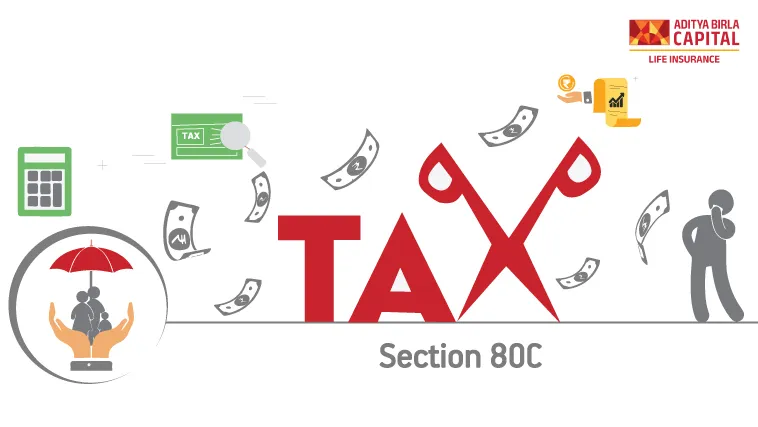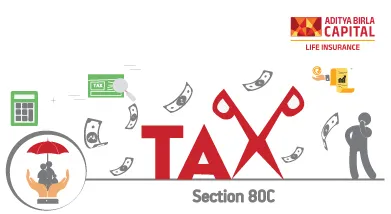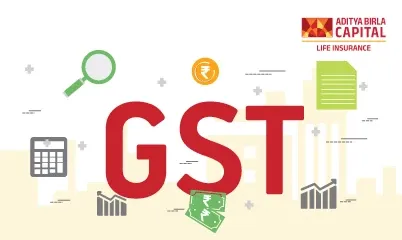Have you ever wondered how you can protect your family's future while also planning for your financial security? Life insurance is one of those critical steps in ensuring that your loved ones remain financially secure, even in your absence. It's more than just a policy; it's peace of mind for you and your family. But what exactly does life insurance cover, and how can it benefit you and your loved ones? Let's dive in and explore the essentials of life insurance, making sure you have all the information you need to make the best decision for your family's future.
What is Section 80C?
Section 80C of the Income Tax Act 1961, is a provision that allows individuals to avail tax benefits* on their investments, including life insurance premiums. In simple terms, the money you invest in a life insurance policy can reduce your taxable income, thus lowering your tax liability. The current limit under Section 80C is up to ₹1.5 lakh per annum. This means if you're paying a premium for a life insurance policy, you can claim a deduction up to this limit, thereby saving on taxes. It's a win-win situation where you not only secure your family's financial future but also enjoy the tax benefits* that come along with it.
Eligibility Criteria
Here are the eligibility criteria for availing the benefits of life insurance under Section 80C:
-
Policyholder: The life insurance policy must be in the name of the individual claiming the deduction. This can be you, your spouse, or your children.
-
Type of Policy: Eligible policies include term insurance, Unit Linked Insurance Plans (ULIPs), and traditional endowment plans. These types of policies qualify for tax benefits* under Section 80C.
-
Premium Payments: The premiums paid towards the life insurance policy are eligible for the deduction. However, there's a limit to how much you can claim, which is currently set at a maximum of ₹1.5 lakh per annum.
-
Tax Laws Compliance: The tax benefits* are in accordance with the prevailing tax laws at the time of claiming the deduction. It's important to stay informed about any changes in the tax rules to maximise your benefits.
-
Validity: The policy must be active and in good standing at the time of claiming the tax benefits*. Lapsed or surrendered policies may not qualify for these deductions.
Remember, these criteria are designed to ensure that individuals are encouraged to invest in life insurance for both protection and tax-saving purposes. Always consult with a tax advisor or financial planner to understand how these eligibility criteria apply to your specific situation.
How to Maximise Tax Saving under Section 80C?
Maximising your tax savings under Section 80C is not just about making investments but making the right investments. Here's how you can ensure you're getting the most out of your tax-saving efforts:
-
Diversify Your Investments: Don't put all your eggs in one basket. Along with life insurance, consider investing in Public Provident Fund (PPF), Equity-Linked Savings Scheme (ELSS), National Savings Certificate (NSC), and five-year fixed deposits. Diversification not only helps in maximising tax savings but also in optimising returns.
-
Invest Early in the Financial Year: Starting your investments early in the year spreads the financial burden and ensures you don't miss out on any interest or returns that accumulate over the year.
-
Utilise the Full Limit: The current limit under Section 80C is ₹1.5 lakh. Make sure you're utilising this entire amount to maximise your tax benefits*. Any amount invested beyond this limit won't fetch you any additional tax benefit* under this section.
-
Plan for Long-Term Benefits: While choosing investments under Section 80C, look for options that not only save tax but also align with your long-term financial goals. For example, life insurance not only provides tax savings but also financial protection for your family.
-
Review and Rebalance: Regularly review your investments to ensure they are aligned with your financial goals and make adjustments as necessary. This might mean rebalancing your portfolio or switching to better-performing funds or policies.
How Much Can Be Claimed Under Section 80C?
Under Section 80C of the Income Tax Act, 1961, an individual or a Hindu Undivided Family (HUF) can claim a deduction of up to ₹1.5 lakh from their total income in a financial year. This limit encompasses various investments and expenses, including life insurance premiums, PPF, ELSS, tuition fees for children, principal repayment on home loans, and others. It's crucial to note that this is a collective limit across all qualifying investments and expenses, not a separate limit for each.
Type of Deductions Applicable for Section 80C
Section 80C offers a wide range of deductions that cater to different financial instruments and expenses. Here are the key types of deductions you can avail of under this section:
-
Life Insurance Premiums: Premiums paid for life insurance policies for yourself, your spouse, or your children are eligible for deduction.
-
Public Provident Fund (PPF): Contributions made to PPF accounts are eligible.
-
Equity-Linked Savings Scheme (ELSS): Investments in ELSS mutual funds qualify for deductions.
-
Home Loan Principal Repayment: The principal amount repaid on a home loan is eligible.
-
Sukanya Samriddhi Yojana (SSY): Contributions made towards SSY for a girl child are eligible.
-
National Savings Certificate (NSC): Purchases of NSC certificates qualify.
-
Fixed Deposits (FDs): Investments in five-year term fixed deposits with banks or post offices are eligible.
-
Tuition Fees: Tuition fees paid for the education of two children are deductible under this section.
Remember, while the aim is to maximise tax savings, it's equally important to choose investments that align with your financial goals and risk appetite. Always consider your long-term financial health alongside immediate tax benefits*.
Deductions Under Section 80C
Section 80C of the Income Tax Act provides a wide array of investment avenues and expenses that can be claimed as deductions, thereby reducing your taxable income. These deductions encourage individuals to save and invest in long-term financial instruments. The maximum limit that can be claimed under Section 80C is ₹1.5 lakh per annum. This includes contributions towards life insurance premiums, Public Provident Fund (PPF), Employee Provident Fund (EPF), Equity Linked Savings Scheme (ELSS), and payment towards the principal amount of home loan, among others.
Expenses Applicable for Section 80C Deductions
Not only investments but certain expenses are also eligible for deductions under Section 80C. These include:
-
Tuition Fees: Fees paid for the full-time education of two children in India.
-
Home Loan Principal Repayment: The principal component of your home loan EMI can be claimed under Section 80C.
-
Stamp Duty and Registration Charges: Expenses incurred on the purchase of a new house including stamp duty and registration fees are eligible for deduction in the year these expenses are incurred.
These expenses encourage individuals to invest in their children's education and in purchasing a new home, thereby securing their family's future while enjoying tax benefits*.
Section 80C Subsections
Section 80C encompasses various subsections that cater to specific investment options or savings schemes, providing a structured way to avail of tax deductions. These include:
-
80CCC: Deductions for contributions to pension funds.
-
80CCD (1): Employee's contribution towards the National Pension System (NPS).
-
80CCD (1B): An additional deduction of up to ₹50,000 for investment in NPS, over and above the limit of ₹1.5 lakh under Section 80C.
-
80CCD (2): Employer's contribution towards NPS, which does not have an upper limit but is capped at 10% of the salary.
These subsections allow for a broader range of investment options and additional tax-saving opportunities beyond the ₹1.5 lakh limit under Section 80C.
Points to Keep in Mind
When planning to avail deductions under Section 80C, consider these points:
-
Eligibility: Ensure your investments or expenses qualify for deductions under Section 80C or its subsections.
-
Limit: The total deduction under Section 80C and its subsections is capped at ₹1.5 lakh per financial year. However, certain investments like NPS (Section 80CCD (1B)) offer additional deductions.
-
Documentation: Keep all relevant documents such as insurance premium receipts, PPF account statements, home loan statements, and tuition fee receipts handy for tax filing purposes.
-
Timing: Investments or payments made within the financial year (April 1st to March 31st) are only eligible for deductions in that year.
-
Tax Planning: Start your tax planning at the beginning of the financial year to spread your investments wisely and avoid last-minute decisions.
By understanding and utilising the provisions under Section 80C and its subsections, you can significantly reduce your tax liability while making smart financial decisions for your future.










